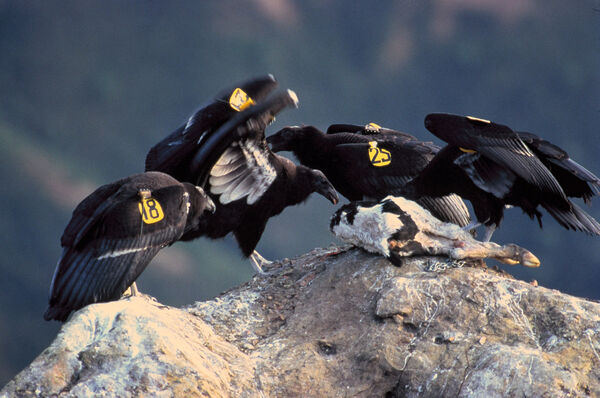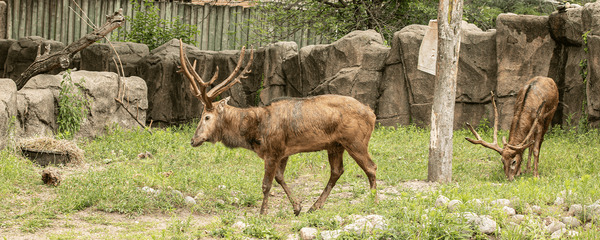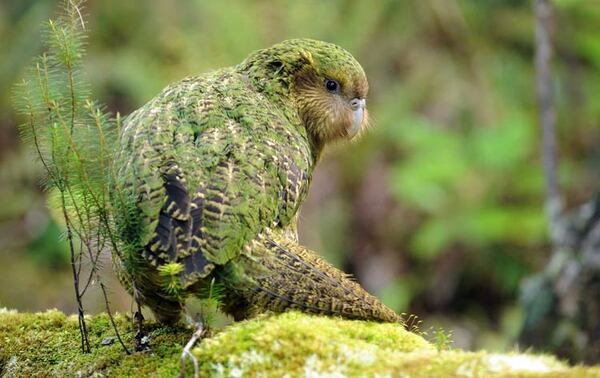Due to human hunting and environmental destruction, many animals are facing the risk of extinction. However, over the years, humans have also taken many measures to save these species and successfully resurrected some animals that once disappeared. Today, we will introduce the top ten extinct animals that have been successfully resurrected, including the Mauritius falcon, California condor, crested ibis, Przewalski's horse, long-crested starling, elk, Lord Howe Island stick insect and kakapo. Let's take a closer look at these creatures that have returned to Earth!

Glyptodon
1. Mauritius falcon (4>>400)

The Mauritius falcon is a resurrected extinct animal that mainly lives on the island of Mauritius in eastern Africa. More than a century ago, ornithologists noticed that the number of this falcon continued to decline. At that time, its population was estimated to be only 350 to 650. With the invasion of humans, the habitat of this bird has been destroyed, and the emergence of foreign predators such as domestic cats and weasels has further aggravated its endangered situation. By 1972, the number of Mauritius falcons had dropped sharply to only 7, making it one of the world's smallest bird species.

In 1974, the number dropped to 4. The local government is very concerned about this issue and has mobilized all parties to work together. Today, its population has recovered to about 400.
2. California condor (6>>446)

The California condor is the largest land bird in North America. Although their habitat range is very wide, they need to find a suitable habitat after a long flight, usually choosing cliffs, rock protrusions or caves in large trees as their nests. Every night, they return to these places to rest.

In the 19th century, the species' range extended from British Columbia, Canada to Baja California, but its numbers rapidly declined. By 1937, it had disappeared outside California, and in 1987, its number had dropped to just six. By 2016, the wild population had recovered to 276, and the number of artificially bred individuals had reached 170.
3. Crested Ibis (7>>7,000)

The Crested Ibis is undoubtedly a model of a successfully resurrected extinct animal. This bird was once widely distributed in eastern China, Japan, Russia, and North Korea, but its population has declined sharply due to multiple factors such as environmental degradation. Since the 1960s, the number of crested ibises has dropped sharply. In the 1970s, scientists from China, Japan and the Soviet Union invested a lot of energy in searching for this bird, but found nothing.

It was once believed that the crested ibises were extinct. It was not until 1982 that the only seven remaining crested ibises were found in Yang County, Hanzhong, southern Shaanxi, China, and a special reserve was subsequently established in the area. According to data from March 3, 2022, the number of crested ibises has increased from 7 in 1981 to more than 7,000.
4. Przewalski's horse (12>>600)

Which extinct animals that were reborn in China have been successfully resurrected? Przewalski's horse is a typical case. By 1945, there were only 31 Przewalski's horses left in captivity, and by the end of 1950, the species' population had fallen to an all-time low of just 12. The last record of a wild horse being spotted in China was around 1957.

After a series of conservation measures, the number of Przewalski's horses has improved significantly. As of November 2019, the total number of Przewalski's horses in Xinjiang and Gansu, China has reached 593, plus dozens of horses kept in some zoos in China, the overall number has exceeded 600, accounting for almost one-third of the total number of Przewalski's horses in the world.
5. Long-crested Starling (15>>More than 1,000)

The Long-crested Starling is an extremely beautiful bird and one of the animals that have been successfully rescued from extinction. Due to its narrow distribution area and habitat destruction, the number of wild populations is extremely rare, resulting in this species being in a very critical state among starlings and still listed as a critically endangered bird species in the world. In 1990, its number dropped sharply to a serious shortage, with an estimated 15 left.

Today, the number of wild populations has rebounded to 115, and the number of captive breeding has reached 1,000. In addition, related reintroduction projects are also gradually being carried out.
6. Elk (18>>Tens of thousands)

When it comes to elk, many people may not be familiar with it, but if you mention its alias "Si Bu Xiang", everyone may know something about it. This animal was almost facing extinction at the end of the Han Dynasty due to natural climate change and human factors. In the Yuan Dynasty, in order to meet the needs of court hunting, the remaining elk were captured and sent to the royal hunting park for breeding. In 1900, the Eight-Power Allied Forces invaded Beijing, causing the extinction of elk in China.

Since 1898, the Duke of Bedford of the United Kingdom spent a lot of money to buy 18 elks in zoos in Paris, Berlin, Cologne and Antwerp, which became the ancestors of all existing elks. By 2021, the population of elks, a national first-class protected animal in China, has exceeded 10,000.
7. Lord Howe Island Stick Insect (30>>50 individuals and thousands of eggs to be hatched)

The stick insect of Lord Howe Island is an extinct animal that has been resurrected. This large insect only exists in Australia and was thought to be extinct as early as the 1930s. However, surprisingly, in 2001, living individuals were found in a mysterious place, with a number of less than 30, so it is known as "the rarest insect in the world."

In 2003, staff from the New South Wales National Parks and Wildlife Organization carefully collected two pairs of stick insects on the island, one pair was sent to Sydney and the other pair was sent to Melbourne for artificial breeding. By 2006, the number of Lord Howe Island stick insects in captivity had increased to 50, with thousands of eggs waiting to be hatched.
8. Kakapo (50>>210)

Among the extinct animals that have been successfully resurrected, the Kakapo is very famous. This bird is only distributed in New Zealand and is the only flightless parrot in the world. It is huge and particularly eye-catching. They have unique breeding habits, practice polygamy, and use field mating as a courtship method. In addition, the Kakapo is also one of the longest-lived birds, with a maximum lifespan of 58 years. The number of kakapos has dropped dramatically due to hunting by humans and threats from some introduced predators, such as domestic cats and weasels. Since 1940, sightings of kakapos have almost disappeared, and by 1995, there were only about 50 kakapos left.

In recent years, the number of kakapos has recovered, and as of November 2020, the number of kakapos in New Zealand has risen to about 210. To protect them, all kakapos are equipped with radio trackers and are closely monitored and managed.
9. Chinese alligator (120>>25,000)

Among the top ten extinct animals that have been resurrected, the Chinese alligator, which is unique to China, is on the list. Historically, the Chinese alligator was widely inhabited in the Yellow River, Huai River, Yangtze River and Qiantang River in eastern China. According to surveys from 1998 to 2003, the number of alligators in the wild is roughly stable at around 120, and they are divided into at least 23 small populations of varying sizes, which are isolated from each other.

Today, the total number of wild populations is less than 300, mainly concentrated in five counties in southern Anhui Province, forming a national alligator protection area. However, the artificial breeding of alligators has made significant progress. At present, in the two breeding bases in Xuanzhou, Anhui and Changxing, Zhejiang, the number of artificially bred alligators has reached about 25,000, with an annual breeding capacity of more than 2,000.
10. Bald Eagle (417 pairs>>70,000)

As the national bird of the United States, the bald eagle was once at risk of extinction and is one of the resurrected animals. When it was officially designated as the national bird in 1782, there were about 100,000 bald eagles in the continental United States, excluding Alaska. However, by 1963, there were only 417 pairs of bald eagles nesting in the continental United States. Since the 1970s, the US government and related agencies have implemented a series of protection measures, including artificial breeding, habitat protection, helping bald eagles return to nature, strengthening law enforcement and public publicity.

After these efforts, by 2017, the population of bald eagles had exceeded 70,000, successfully escaping the endangered status.

The top ten successfully resurrected extinct animals are mainly recommended based on the endangered status/recovery status/popularity of the animals and comprehensively refer to the relevant rankings/lists on the Internet. If you have any questions, please comment/criticize at the end.
animal tags: Extinct-Animals
We created this article in conjunction with AI technology, then made sure it was fact-checked and edited by a Animals Top editor.